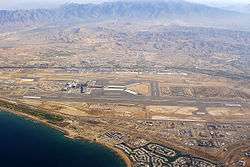Muscat
| Muscat مسقط | |
|---|---|
| City | |
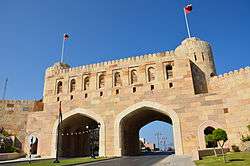 Muscat Gate | |
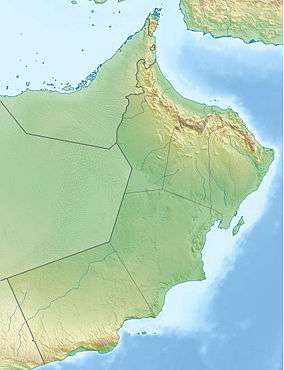 Muscat Location of Muscat in Oman 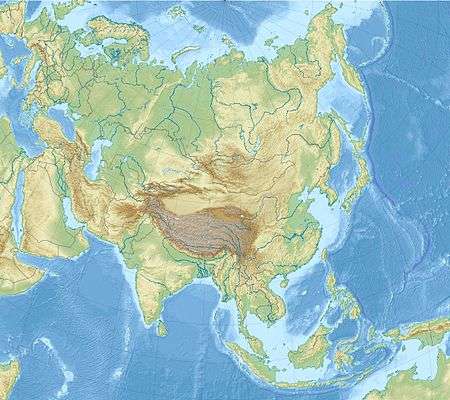 Muscat Muscat (Asia) | |
| Coordinates: 23°35′20″N 58°24′30″E / 23.58889°N 58.40833°ECoordinates: 23°35′20″N 58°24′30″E / 23.58889°N 58.40833°E | |
| Country |
|
| Governorate | Muscat |
| Government | |
| • Type | Absolute monarchy |
| • Sultan | Qaboos bin Said |
| Area | |
| • Land | 273.9 km2 (105.8 sq mi) |
| • Metro | 3,797 km2 (1,466 sq mi) |
| Population (May 2017) | 1,560,330 |
| • Density | 450/km2 (1,200/sq mi) |
| • Metro | 1,560,330 [1] |
| Time zone | UTC+4 (GST) |
| Website | Muscat Municipality |
Muscat (Arabic: مسقط, Masqaṭ pronounced [ˈmasqatˤ]) is the capital and largest city of Oman. It is the seat of the Governorate of Muscat. According to the National Centre for Statistics and Information (NCSI), the total population of Muscat Governorate reached 1.28 million as of September 2015.[2] The metropolitan area spans approximately 3,500 km2 (1,400 sq mi)[3] and includes six provinces called wilayats. Known since the early 1st century CE as an important trading port between the west and the east, Muscat was ruled by various indigenous tribes as well as foreign powers such as the Persians, the Portuguese Empire, the Iberian Union and the Ottoman Empire at various points in its history. A regional military power in the 18th century, Muscat's influence extended as far as East Africa and Zanzibar. As an important port-town in the Gulf of Oman, Muscat attracted foreign tradesmen and settlers such as the Persians and the Balochis. Since the ascension of Qaboos bin Said as Sultan of Oman in 1970, Muscat has experienced rapid infrastructural development that has led to the growth of a vibrant economy and a multi-ethnic society.
The rocky Western Al Hajar Mountains dominate the landscape of Muscat. The city lies on the Arabian Sea along the Gulf of Oman and is in the proximity of the strategic Straits of Hormuz. Low-lying white buildings typify most of Muscat's urban landscape, while the port-district of Muttrah, with its corniche and harbour, form the north-eastern periphery of the city. Muscat's economy is dominated by trade, petroleum and porting.
Etymology
Ptolemy's Map of Arabia identifies the territories of Cryptus Portus[4] and Moscha Portus.[5] Scholars are divided in opinion on which of the two related to the city of Muscat. Similarly, Arrianus references Omana and Moscha in Voyage of Nearchus. Interpretations of Arrianus' work by William Vincent and Jean Baptiste Bourguignon d'Anville conclude that Omana was a reference to Oman, while Moscha referred to Muscat.[6] Similarly, other scholars identify Pliny the Elder's reference to Amithoscuta to be Muscat.[4]
The origin of the word Muscat is disputed. Some authors claim that the word has Arabic origins – from moscha, meaning an inflated hide or skin.[7] Other authors claim that the name Muscat means anchorage or the place of "letting fall the anchor".[8] Other derivations include muscat from Old Persian, meaning strong-scented,[9] or from Arabic, meaning falling-place,[10] or hidden.[11] Cryptus Portus is synonymous with Oman ("hidden land"). But "Ov-man" (Omman), and the old Sumerian name Magan (Maa-kan), means sea-people in Arabic. An inhabitant is a Muscatter, Muscatian, Muscatite or Muscatan.
History
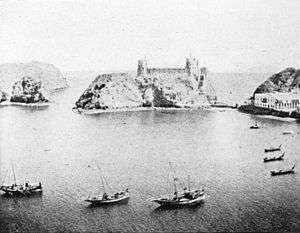
_(14577292147)_(cropped).jpg)
Evidence of communal activity in the area around Muscat dates back to the 6th millennium BCE in Ras al-Hamra, where burial sites of fishermen have been found. The graves appear to be well formed and indicate the existence of burial rituals. South of Muscat, remnants of Harappan pottery indicate some level of contact with the Indus Valley Civilisation.[12] Muscat's notability as a port was acknowledged as early as the 1st century CE by the Greek geographer Ptolemy, who referred to it as Cryptus Portus (the Hidden Port), and by Pliny the Elder, who called it Amithoscuta.[13]
The port fell to a Sassanid invasion in the 3rd century CE, under the rule of Shapur I,[14] while conversion to Islam occurred during the 7th century. Muscat's importance as a trading port continued to grow in the centuries that followed, under the influence of the Azd dynasty, a local tribe. The establishment of the First Imamate in the 9th century CE was the first step in consolidating disparate Omani tribal factions under the banner of an Ibadi state. However, tribal skirmishes continued, allowing the Abbasids of Baghdad to conquer Oman. The Abbasids occupied the region until the 11th century, when they were driven out by the local Yahmad tribe. Power over Oman shifted from the Yahmad tribe to the Azdi Nabahinah clan, during whose rule, the people of coastal ports such as Muscat prospered from maritime trade and close alliances with the Indian subcontinent, at the cost of the alienation of the people of the interior of Oman.
The Portuguese admiral Afonso de Albuquerque sailed to Muscat in 1507, in an attempt to establish trade relations. As he approached the harbor, his ships were fired on. He then decided to conquer Muscat. Most of the city burned to the ground during and after the fighting.
The Portuguese maintained a hold on Muscat for over a century, despite challenges from Persia and a bombardment of the town by the Ottoman Turks in 1546.[15] The Turks twice captured Muscat from the Portuguese, in the Capture of Muscat (1552) and 1581-88. The election of Nasir bin Murshid Al-Ya'rubi as Imam of Oman in 1624 changed the balance of power again in the region, from the Persians and the Portuguese to local Omanis. On August 16, 1648 the Imam dispatched an army to Muscat, which captured and demolished the high towers of the Portuguese, weakening their grip over the town. Decisively, in 1650, a small but determined body of the Imam's troops attacked the port at night, forcing an eventual Portuguese surrender on January 23, 1650.[16] A civil war and repeated incursions by the Persian king Nader Shah in the 18th century destabilised the region, and further strained relations between the interior and Muscat. This power vacuum in Oman led to the emergence of the Al Bu Sa‘id dynasty, which has ruled Oman ever since.[17]
—Afonso de Albuquerque, after the fall of Muscat, in 1507.[18]
Muscat's naval and military supremacy was re-established in the 19th century by Said bin Sultan, who signed a treaty with U.S. President Andrew Jackson's representative Edmund Roberts on September 21, 1833.[19] Having gained control over Zanzibar, in 1840 Said moved his capital to Stone Town, the ancient quarter of Zanzibar City; however, after his death in 1856, control over Zanzibar was lost when it became an independent sultanate under his sixth son, Majid bin Said (1834/5–1870), while the third son, Thuwaini bin Said, became the Sultan of Oman. During the second half of the 19th century, the fortunes of the Al Bu Sa`id declined and friction with the Imams of the interior resurfaced. Muscat and Muttrah were attacked by tribes from the interior in 1895 and again in 1915.[20] A tentative ceasefire was brokered by the British, which gave the interior more autonomy. However, conflicts among the disparate tribes of the interior, and with the Sultan of Muscat and Oman continued into the 1950s, and eventually escalated into the Dhofar Rebellion (1962). The rebellion forced the Sultan Said bin Taimur to seek the assistance of the British in quelling the uprisings from the interior. The failed assassination attempt of April 26 1966 on Said bin Taimur led to the further isolation of the Sultan, who had moved his residence from Muscat to Salalah, amidst the civilian armed conflict. On July 23, 1970, Qaboos bin Said, son of the Sultan, staged a bloodless[21] coup d'état in the Salalah palace with the assistance of the British, and took over as ruler.
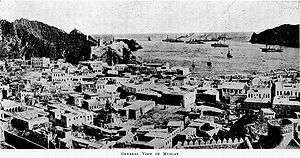
With the assistance of the British, Qaboos bin Said put an end to the Dhofar uprising and consolidated disparate tribal territories. He renamed the country the Sultanate of Oman (called Muscat and Oman hitherto), in an attempt to end to the interior's isolation from Muscat. Qaboos enlisted the services of capable Omanis to fill positions in his new government,[22] drawing from such corporations as Petroleum Development Oman (PDO). New ministries for social services such as health and education were established. The construction of Mina Qaboos, a new port conceived initially by Sa`id bin Taimur, was developed during the early days of Qaboos' rule. Similarly, a new international airport was developed in Muscat's Seeb district. A complex of offices, warehouses, shops and homes transformed the old village of Ruwi in Muttrah into a commercial district.[23] The first five-year development plan in 1976 emphasised infrastructural development of Muscat, which provided new opportunities for trade and tourism in the 1980s – 1990s, attracting migrants from around the region. On June 6, 2007, Cyclone Gonu hit Muscat causing extensive damage to property, infrastructure and commercial activity.
Early photographs of the city and harbor, taken in the early 20th century by German explorer and photographer, Hermann Burchardt, are now held at the Ethnological Museum of Berlin.[24]
Geography and geology
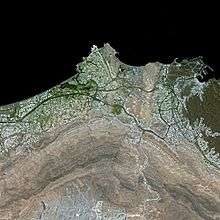
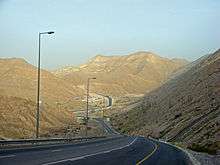
Muscat is located in northeast Oman. The Tropic of Cancer passes south of the area. It is bordered to its west by the plains of the Al Batinah Region and to its east by Ash Sharqiyah Region. The interior plains of the Ad Dakhiliyah Region border Muscat to the south, while the Gulf of Oman forms the northern and western periphery of the city. The water along the coast of Muscat runs deep, forming two natural harbours, in Muttrah and Muscat. The Western Al Hajar Mountains run through the northern coastline of the city.
Volcanic rocks composed of serpentine and diorite are apparent in the Muscat area and extend along the Gulf of Oman coast for ten or twelve 16 kilometres (9.9 mi) from the district of Darsait to Yiti.[25] Plutonic rocks constitute the hills and mountains of Muscat and span approximately 30 miles (48 km) from Darsait to Ras Jissah. These igneous rocks consists of serpentine, greenstone, and basalt, typical of rocks in southeastern regions of the Arabian Peninsula. South of Muscat, the volcanic rock strata are broken up and distorted, rising to a maximum height of 6,000 feet (1,800 m), in Al Dakhiliyah, a region which includes Jebel Akhdar, the country's highest range. The hills in Muscat are mostly devoid of vegetation but are rich in iron.
The halophytic sabkha type desert vegetation is predominant in Muscat.[26] The Qurum Nature Reserve contains plants such as the Arthrocnemum Macrostachyum and Halopeplis Perfoliata. Coral reefs are common in Muscat. Acropora reefs exist in the sheltered bays of the satellite towns of Jussah and Khairan.[27] Additionally, smaller Porites reef colonies exist in Khairan, which have fused to form a flat-top pavement that is visible at low tide. Crabs and spiny crayfish are found in the waters of the Muscat area, as are sardines and bonito.[28] Glassfish are common in freshwater estuaries, such as the Qurum Nature Reserve.[29]
The Sultan Qaboos Street forms the main artery of Muscat, running west-to-east through the city. The street eventually becomes Al Nahdah Street near Al Wattayah. Several inter-city roads such as Nizwa Road and Al Amrat Road, intersect with Al Sultan Qaboos Road (in Rusail and Ruwi, respectively). Muttrah, with the Muscat Harbour, Corniche, and Mina Qaboos, is located in the north-eastern coastline of the city, adjacent to the Gulf of Oman. Other coastal districts of Muscat include Darsait, Mina Al Fahal, Ras Al Hamar, Al Qurum Heights, Al Khuwair and Al Seeb. Residential and commercial districts further inland include Al Hamriyah, Al Wadi Al Kabir, Ruwi, Al Wattayah, Madinat Qaboos, Al Azaiba and Al Ghubra.
Climate
Muscat features a hot, arid climate (Köppen climate classification BWh) with long and very hot summers and warm "winters". Annual rainfall in Muscat is about 10 cm (4 in), falling mostly from December to April. In general precipitation is scarce in Muscat, with several months on average seeing only a trace of rainfall. However, in recent years, heavy precipitation events from tropical systems originating in the Arabian Sea have affected the city. Cyclone Gonu in June 2007 and Cyclone Phet in June 2010 affected the city with damaging winds and rainfall amounts exceeding 100 mm (4 in) in just a single day. The climate generally is very hot and also very humid in the summer, with temperatures frequently reaching as high as 40 °C (104 °F) in the summer.
| Climate data for Muscat | |||||||||||||
|---|---|---|---|---|---|---|---|---|---|---|---|---|---|
| Month | Jan | Feb | Mar | Apr | May | Jun | Jul | Aug | Sep | Oct | Nov | Dec | Year |
| Record high °C (°F) | 34.6 (94.3) |
38.2 (100.8) |
41.5 (106.7) |
44.9 (112.8) |
48.3 (118.9) |
48.5 (119.3) |
49.1 (120.4) |
49.2 (120.6) |
47.2 (117) |
43.6 (110.5) |
39.4 (102.9) |
37.8 (100) |
49.2 (120.6) |
| Average high °C (°F) | 25.5 (77.9) |
26.1 (79) |
29.8 (85.6) |
34.7 (94.5) |
39.5 (103.1) |
40.4 (104.7) |
38.6 (101.5) |
36.2 (97.2) |
36.3 (97.3) |
35.0 (95) |
30.5 (86.9) |
27.1 (80.8) |
33.3 (92) |
| Daily mean °C (°F) | 21.3 (70.3) |
21.9 (71.4) |
25.2 (77.4) |
29.8 (85.6) |
34.2 (93.6) |
35.2 (95.4) |
34.3 (93.7) |
32.0 (89.6) |
31.4 (88.5) |
29.7 (85.5) |
25.7 (78.3) |
22.6 (72.7) |
28.6 (83.5) |
| Average low °C (°F) | 17.3 (63.1) |
17.6 (63.7) |
20.7 (69.3) |
24.7 (76.5) |
29.1 (84.4) |
30.6 (87.1) |
30.4 (86.7) |
28.4 (83.1) |
27.5 (81.5) |
24.9 (76.8) |
20.9 (69.6) |
18.9 (66) |
24.3 (75.7) |
| Record low °C (°F) | 1.6 (34.9) |
2.3 (36.1) |
7.0 (44.6) |
10.3 (50.5) |
17.2 (63) |
21.6 (70.9) |
23.5 (74.3) |
21.3 (70.3) |
19.0 (66.2) |
14.3 (57.7) |
9.4 (48.9) |
4.5 (40.1) |
1.6 (34.9) |
| Average precipitation mm (inches) | 12.8 (0.504) |
24.5 (0.965) |
15.9 (0.626) |
17.1 (0.673) |
7.0 (0.276) |
0.9 (0.035) |
0.2 (0.008) |
0.8 (0.031) |
0.0 (0) |
1.0 (0.039) |
6.8 (0.268) |
13.3 (0.524) |
100.3 (3.949) |
| Average relative humidity (%) | 63 | 64 | 58 | 45 | 42 | 49 | 60 | 67 | 63 | 55 | 60 | 65 | 58 |
| Mean monthly sunshine hours | 268.6 | 244.8 | 278.3 | 292.5 | 347.4 | 325.7 | 277.7 | 278.6 | 303.9 | 316.9 | 291.9 | 267.0 | 3,493.3 |
| Source: NOAA [30] | |||||||||||||
Economy
.jpg)
Muscat's economy, like that of Oman, is dominated by trade. The more traditional exports of the city included dates, mother of pearl, and fish. Many of the souks of Muttrah sell these items and traditional Omani artefacts. Petroleum Development Oman (PDO) has been central to Muscat's economy since at least 1962 and is the country's second largest employer, after the government. PDO's major shareholders include Royal Dutch/Shell, Total, and Partex and its production is estimated to be about 720,000 barrels per day (114,000 m3/d). Muscat also has major trading companies such as Suhail Bahwan Group, which is a trading partner for corporations such as Toshiba, Subaru, Seiko, Hewlett Packard, General Motors, RAK Ceramics; Saud Bahwan Group whose trading partners are Toyota, Daihatsu, KIA and Hertz Rent-a-Car; Zubair Automotive whose trading partners include Mitsubishi, and Chrysler brands such as Dodge; and Moosa AbdulRahman Hassan which operates as one of the oldest automotive agencies in the entire region being established in 1927. The private Health Care sector of Muscat, Oman has numerous hospitals and clinics.
The Muscat Securities Market is the principal stock exchange of Oman. It is located in Central Business District of Muscat and it was established in 1988, and has since distinguished itself as a pioneer among its regional peers in terms of transparency and disclosure regulations and requirements.
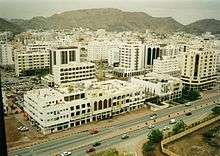
Mina'a Sultan Qaboos, Muscat's main trading port, is a trading hub between the Persian Gulf, the Indian subcontinent and the Far East with an annual volume of about 1.6 million tons. However, the emergence of the Jebel Ali Free Zone in neighboring Dubai, United Arab Emirates, has made that port the premier maritime trading port of the region with about 44 million tons traded in cargo annually. Many infrastructural facilities are owned and operated by the government of Oman. Omantel is the major telecommunications organization in Oman and provides local, long-distance and international dialing facilities and operates as the country's only ISP. Recent liberalization of the mobile telephone market has seen the establishment of a second provider — Ooredoo.
Muscat is home to multibillion-dollar conglomerate Ck Industries with their headquarters located in Ruwi.[31] Ajman based Amtek Industries also have a couple of offices around the city.[31] It is also home to Galfar Engineering,[32] headed by P. Mohammed Ali.
The airline Oman Air has its head office on the grounds of Muscat International Airport.[33]
Demographics
According to the 2003 census conducted by the Oman Ministry of National Economy, the population of Muscat is over 630,000, which included 370,000 males and 260,000 females.[34] Muscat formed the second largest governorate in the country, after Al Batinah, accounting for 27% of the total population of Oman. As of 2003, Omanis constituted 60% of the total population of Muscat, while expatriates accounted for about 40%.[35] The population density of the city was 162.1 per km2.

The governorate of Muscat comprises six wilayats: Muttrah, Bawshar, Seeb, Al Amrat, Muscat and Qurayyat. Of the wilayats, Seeb, located in the western section of the governorate, was the most populous (with over 220,000 residents), while Muttrah had the highest number of expatriates (with over 100,000).[34] Approximately 71% of the population was within the 15–64 age group, with the average Omani age being 23 years.[36] About 10% of the population is illiterate, an improvement when compared to the 18% illiteracy rate recorded during the 1993 census. Expatriates accounted for over 60% of the labour force, dominated by males, who accounted for 80% of the city's total labour. A majority of expatriates (34%) engineering-related occupations, while most Omanis worked in engineering, clerical, scientific or technical fields. The defense sector was the largest employer for Omanis, while construction, wholesale and retail trade employed the largest number of expatriates.
The ethnic makeup of Muscat has historically been influenced by people not native to the Arabian Peninsula. British Parliamentary papers dating back to the 19th century indicate the presence of a significant Hindu Gujarati merchants in the city[37] Indeed, four Hindu temples existed in Muscat ca. 1760.[38] Christianity flourished in Oman (Bēṯ Mazūnāyē "land of the Maganites"; a name deriving from its Sumerian designation) from the late 4th century to early 5th century. Missionary activity by the Assyrians of the Church of the East resulted in a significant Christian population living in the region, with a bishop being attested by 424 AD under the Metropolitan of Fars and Arabia. The rise of Islam saw the Syriac and Arabic-speaking Christian population eventually disappear. It is thought to have been brought back in by the Portuguese in 1507.[39] Protestant missionaries established a hospital in Muscat in the 19th century.
Like the rest of Oman, Arabic is the predominant language of the city. In addition, English, Balochi, Swahili and South Asian languages such as Bengali, Hindi, Konkani, Marathi, Gujarati, Malayalam, Tamil and Urdu[40] are spoken by the residents of Muscat. Islam is the predominant religion in the city, with most followers being Ibadi Muslims. Non-Muslims are allowed to practice their religion, but may not proselytize publicly or distribute religious literature.
Notable landmarks

The city has numerous mosques including the Sultan Qaboos Grand Mosque, Ruwi Mosque, Saeed bin Taimoor and Zawawi Mosque. A few Shi'ite mosques also exist here.
Muscat has a number of museums. These include Museum of Omani Heritage, National Museum of Oman, Oman Children's Museum, Bait Al Zubair, Oman Oil and Gas Exhibition Centre, Omani French Museum, Sultan's Armed Forces Museum and the Omani Aquarium and Marine Science and Fisheries Centre.[41] The Bait Al Falaj Fort played an important role in Muscat's military history.
Recent projects include an opera house which opened on October 14, 2011. One of the most notable new projects is the Oman National Museum. It is expected to be an architectural jewel along with the Sultan Qaboos Grand Mosque.
Visitors are also encouraged to visit Old Muscat and the Old Palace. The main shopping district is situated in Al Qurum Commercial Area, however shopping malls are spread out throughout the city. One of the largest malls in Oman is Oman Avenues Mall, located in Ghubra.The second largest and new contemporary mall is in Seeb, near the international airport, called City Center, housing all major international brands and the largest Carrefour hypermarket.
The main airport is Muscat International Airport around 25 km (16 mi) from the city's business district of Ruwi and 15 to 20 km from the main residential localities of Al-Khuwair, Madinat Al Sultan Qaboos, Shati Al-Qurm and Al-Qurm. Muscat is the headquarters for the local Oman Air, which flies to several destinations within the Middle East, the Indian Subcontinent, East Africa and Europe. Other airlines such as Qatar Airways, Turkish Airlines, KLM, SriLankan, Royal Jordanian, British Airways, PIA, Jet Airways, Lufthansa, Emirates, Swiss International Air Lines, Kuwait Airways, Air India and Thai Airways also fly through Muscat International Airport.
The Muscat area is well serviced by paved roads and dual-carriageway connects most major cities and towns in the country. Since November 2015, Public transportation in Muscat has been revamped with a bus network connecting most important parts of the city with a modern Mwasalat (earlier Oman National Transport Company (ONTC) buses. Mwasalat buses were procured from VDL Company of The Netherlands and they have several hi-tech features. Route 1 (Ruwi-Mabela) serves people travelling major shopping destinations (Oman Avenues Mall, Muscat Grand Mall, Qurum City Centre, Muscat City Centre, Markaz al Bhaja) and Muscat Airport. Route 2 (Ruwi-Wadi Kabir) serves the residential and industrial district of Wadi Kabir. Route 3 (Ruwi-Wadi Adei) serves the downmarket residential belt of Wadi Adei. Route 4 (Ruwi-Mattrah) serves the tourist destination of Muttrah Corniche, Al Alam Palace, National Museum and Port Sultan Qaboos. Route 5 (Ruwi-Amerat) serves the rapidly developing Amerat suburb. Route 6 (Ruwi-SQU&KOM) serves the student community of Sultan Qaboos University (SQU) and the office commuters of Knowledge Oasis Muscat (KOM).
There is no rail or metro network in the country. Several forms of public transport are popular in Oman. Most popular are the "Baiza" buses, so named for the lower denomination of the Omani rial, the baiza (an adaptation of the Indian lower denomination paisa). These are relatively inexpensive and service all major roadways, as well as a wide and loose network of smaller byways in the greater Muscat metropolitan area, opportunistically dropping off and picking up passengers at any location. Less popular and slightly more expensive are large public buses, coloured red and green, whose service is limited to major roadways and point-to-point travel routes between Oman's major cities and towns. Taxis, also colour-coded orange and white, provide semi-personal transportation in the form of both individual hire and the same opportunistic roadway service as Baiza buses.
Baiza buses and colour-coded orange-and-white taxis are unmetered, after several government initiatives to introduce meters were rejected. The fare is set by way of negotiation, although taxi drivers usually adhere to certain unwritten rules for fares within the city. In many countries, one is advised to negotiate a fare with the driver before getting into a taxi. However, in Oman, asking for the fare beforehand often demonstrates a passenger's newness and unfamiliarity with the area. One should always find out the normally accepted fare for one's journey from one's hotel or host before looking for a taxi. Taxis will also generally take passengers to locations out of the city, including Sohar, Buraimi and Dubai.
A rail network named Oman Rail is expected to be completed by 2018. This will connect Oman with the GCC countries.
Culture
Outwardly, Oman shares many of the cultural characteristics of its Arab neighbours, particularly those in the Gulf Cooperation Council.[43] Despite these similarities, important factors make Oman unique in the Middle East.[43] These result as much from geography and history as from culture and economics.[43] The relatively recent and artificial nature of the state in Oman makes it difficult to describe a national culture;[43] however, sufficient cultural heterogeneity exists within its national boundaries to make Oman distinct from other Arab States of the Persian Gulf.[43] Oman's cultural diversity is greater than that of its Arab neighbours, given its historical expansion to the Swahili Coast and the Indian Ocean.[43]
Oman has a long tradition of shipbuilding, as maritime travel played a major role in the Omanis' ability to stay in contact with the civilisations of the ancient world. Sur was one of the most famous shipbuilding cities of the Indian Ocean. The Al Ghanja ship takes one whole year to build. Other types of Omani ship include As Sunbouq and Al Badan.[44]
In March 2016 archaeologists working off Al Hallaniyah Island identified a shipwreck believed to be that of the Esmeralda from Vasco da Gama's 1502–1503 fleet. The wreck was initially discovered in 1998. Later underwater excavations took place between 2013 and 2015 through a partnership between the Oman Ministry of Heritage and Culture and Bluewater Recoveries Ltd., a shipwreck recovery company. The vessel was identified through such artifacts as a "Portuguese coin minted for trade with India (one of only two coins of this type known to exist) and stone cannonballs engraved with what appear to be the initials of Vincente Sodré, da Gama's maternal uncle and the commander of the Esmeralda."[45]
Sports
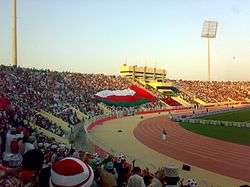
.jpg)
In October 2004, the Omani government set up a Ministry of Sports Affairs to replace the General Organization For Youth, Sports And Cultural Affairs. The 19th Arabian Gulf Cup, the 19th edition, took place in Muscat, from 4 to 17 January 2009 and was won by the Omani national football team. The 23rd Arabian Gulf Cup, the 23rd edition, that took place in Kuwait, from 22 December 2017 until January 5th 2018. Oman won their second title, defeating the United Arab Emirates in the final on penalties following a goalless draw.
The Oman Olympic Committee played a major part in organizing the highly successful 2003 Olympic Days, which were of great benefit to the sports associations, clubs and young participants. The football association took part, along with the handball, basketball, rugby union, hockey, volleyball, athletics, swimming, and tennis associations. In 2010 Muscat hosted the 2010 Asian Beach Games.
Football and cricket are the most popular sports in Muscat. Two teams (Muscat Club and Oman Club) represent Oman in Oman Professional League.
Oman also hosts tennis tournaments in different age divisions each year. The Sultan Qaboos Sports Complex stadium contains a 50-meter swimming pool which is used for international tournaments from different schools in different countries. The Tour of Oman, a professional cycling 6-day stage race, takes place in February. Oman hosted the Asian 2011 FIFA Beach Soccer World Cup qualifiers, where 11 teams competed for three spots at the FIFA World Cup. Oman hosted the Men's and Women's 2012 Beach Handball World Championships at the Millennium Resort in Mussanah, from 8 to 13 July.[46] Oman has competed repeatedly for a position in the FIFA World Cup, but have yet qualified to compete in the tournament.
In Cricket, Oman qualified for the 2016 ICC World Twenty20 by securing sixth place in 2015 ICC World Twenty20 Qualifier. They have also been granted T20I status as they were among the top six teams in the qualifiers.
Notable people
- Mahesh Bhupathi (b. 1974), Indian tennis player, studied at the Indian School, Muscat
- Sarah-Jane Dias (b. 1974), Indian Actress, studied at the Indian School, Muscat
- Isla Fisher (b. 1976), Australian actress, born to Scottish parents and lived in Australia
- Ali Al-Habsi (b. 1981), Omani professional footballer, captain of the Oman national and goalkeeper for Saudi club Al Hilal
- Sneha Ullal (b. 1987), Indian Bollywood Actress, studied at the Indian School, Muscat
- Avicii (b. 1989), Swedish musician and DJ Tim Bergling died in Muscat on April 20th 2018 from self-inflicted injuries
See also
Bibliography
- Barth, Hans-Jörg; Benno Böer (2002). Sabkha Ecosystems: The Arabian Peninsula and Adjacent Countries. Springer. ISBN 978-1-4020-0504-6.
- Fahlbusch, Erwin; Geoffrey William Bromiley; David B. Barrett (1999). The Encyclopedia of Christianity. Wm. B. Eerdmans Publishing. ISBN 978-0-8028-2415-8.
- Forster, Charles, The Historical Geography of Arabia: Or, The Patriarchal Evidences of Revealed Religion : a Memoir, Duncan and Malcolm, 1844
- Ghazanfar, Shahina A.; Martin Fisher (1998). Vegetation of the Arabian Peninsula. Springer. ISBN 978-0-7923-5015-6.
- Kechichian, Joseph A. (1995). Oman and the World: The Emergence of an Independent Foreign Policy. Great Britain: RAND Corporation. ISBN 978-0-8330-2332-2.
- Long, David E.; Reich, Bernard; Gasiorowski, Mark (2007). The Government and Politics of the Middle East and North Africa. Westview Press. ISBN 978-0-8133-4361-7.
- Miles, Samuel Barrett; Robin Bidwell. The Countries and Tribes of the Persian Gulf. Garnet & Ithaca Press.
- Peterson, J. E. (2007). "Chronology". Historical Muscat. Brill. p. 117+. ISBN 90-04-15266-0.
- Phillips, Wendell (1966). Unknown Oman. D. McKay Co. p. 4.
- Potter, Lawrence; Sick, Gary (2002). Security in the Persian Gulf. Macmillan. ISBN 978-0-312-23950-3.
- Rice, Michael (1994). The Archeology of the Arabian Gulf. Routledge. ISBN 978-0-415-03268-1.
- Room, Adrian (2003). Placenames of the World: Origins and Meanings of the Names for Over 5000 Natural Features, Countries, Capitals, Territories, Cities and Historic Sites. McFarland. ISBN 978-0-7864-1814-5.
- Salm, Rodney V.; Rolf A.C. Jensen; Vassili Papastavrou (1993). Marine Fauna of Oman. IUCN. ISBN 978-2-8317-0180-6.
References
- ↑ "UNdata - country profile - Oman".
- ↑ "The population of the Sultanate by the end of May 2015".
- ↑ الدراسات الاجتماعية. Ministry of Education, Sultanate of Oman.
- 1 2 Forster (1844), p.231.
- ↑ Forster (1844), p.241.
- ↑ Forster (1844), p.173.
- ↑ Forster (1844), p.173
- ↑ Miles (1997), p.468.
- ↑ Hailman (2006), p.49.
- ↑ Philips (1966), p.4.
- ↑ Room (2003), p.246.
- ↑ Rice (1994), p.255-256
- ↑ Forster (1844), p.234.
- ↑ Potter (2002), p.41.
- ↑ Miles (1997), p.167
- ↑ Miles (1997), p. 196.
- ↑ Miles (1997), p.256.
- ↑ Miles (1997), p.147.
- ↑ Cotheal, Alexander I. (2008-01-17). "Treaty between the United States of America and the Sultân of Masḳaṭ: The Arabic Text". Journal of the American Oriental Society (free)
|format=requires|url=(help). JSTOR. 4 (1854): 341&ndash, 343. JSTOR 592284. - ↑ JE Peterson's Britannica entry (1990), p.6.
- ↑ Long (2007), p.188.
- ↑ Middle East Policy (2004), p.126.
- ↑ Middle East Policy (2004), p.128
- ↑ View of the city and city walls in 1904 (Click on photo to enlarge); Muscat's wall and gate.
- ↑ Miles (1997), p. 399.
- ↑ Ghazanfar (1998), p. 80.
- ↑ Salm (1993), p. 52
- ↑ Miles (1997), p. 410.
- ↑ Barth (2002), p. 292.
- ↑ "Seeb Climate Normals". National Oceanic and Atmospheric Administration. Retrieved December 19, 2012.
- 1 2 "Amtek". Amtek.ae. Retrieved 2014-02-18.
- ↑ "Contact". Galfar.com. Retrieved 2014-02-18.
- ↑ "Contact Us". Omanair.com. Archived from the original on 2012-11-20.
- 1 2 Oman Census (2003), p.6.
- ↑ Oman Census (2003), p.9.
- ↑ Oman Census(2003), Data and Other Indicators
- ↑ British Parliamentary Papers (1876), p. 189.
- ↑ Kechichian (1995), p. 215.
- ↑ Fahlbusch (1999), p. 829.
- ↑ Peterson (2004), p. 34.
- ↑ "Museums". Omanet.om. Archived from the original on February 1, 2009. Retrieved January 18, 2009.
- ↑ "Culture of Oman". Sultanate of Oman.
- 1 2 3 4 5 6 Common, Richard K. "Barriers To Developing 'Leadership' In The Sultanate Of Oman" (PDF). International Journal of Leadership Studies.
- ↑ "The Ship Building Industry". Ministry of Tourism, Sultanate of Oman.
- ↑ Romey, Kristin (14 March 2016). "Shipwreck Discovered from Explorer Vasco da Gama's Fleet". National Geographic. Retrieved 15 March 2016.
- ↑ "The Beach Handball 2012 World Championships". 8 July 2012. Retrieved 24 September 2012.
Further reading
- omancensus.net (PDF)
- 2010 Preliminary Results (PDF)
- Census Administration. "Final Results of the Census 2003" (PDF). Ministry of the National Economy, Government of Oman. Archived from the original (PDF) on October 3, 2008. Retrieved 2008-09-17.
- Census Administration. "Data & Indicators of the Population". Ministry of the National Economy, Government of Oman. Archived from the original on 2008-06-13. Retrieved 2008-09-17.
- Parliamentary Papers. London: United Kingdom Parliament. 1876.
External links
| Wikimedia Commons has media related to Muscat. |
| Wikivoyage has a travel guide for Muscat. |
- Ministry of Foreign Affairs
- Official Ministry Of Tourism site
- omancensus.net (PDF)
- Oman Avenues Mall
